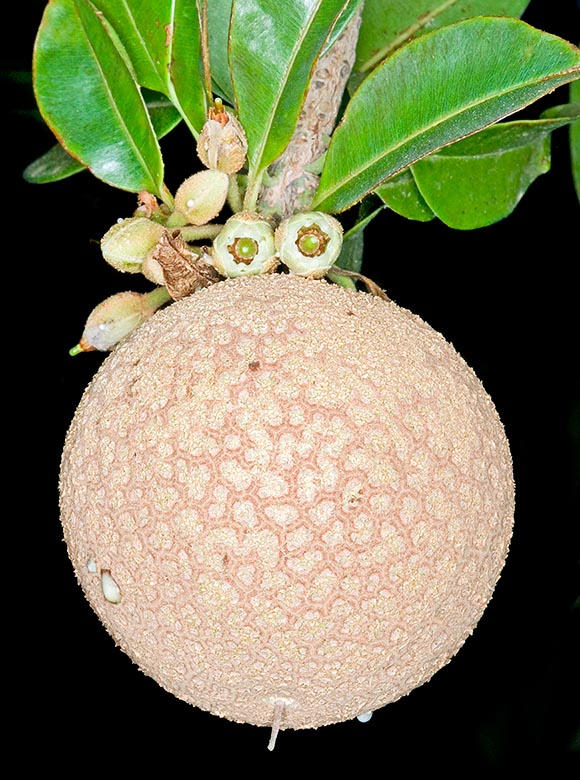Family : Sapotaceae

Text © Pietro Puccio

English translation by Mario Beltramini

At home in Central America, Manilkara zapota is slow growing but may reach 20 m of height © Giuseppe Mazza
The generic name is the local Indian name “manil-kara” utilized for indicating the plant described as Manilkara kauki (L.) Dubard; the specific name comes from the Nauhatl (Aztec) “tzapotl” utilized to indicate several fruits having morbid and sweet pulp.
Common names: chicle, chico, dilly, marmalade plum, naseberry, red sapodilla, sapote (English); baramasi (Bengali); sapoti (Brazilian); ren xin guo (Chinese); nèfle d’Amérique, sapote, sapoti, sapotier, sapotille, sapotillier (French); chikoo (Hindi); sao Manila, sawo, sawo Manila (Indonesian); chico, chicosapote, chicozapote, níspero, sapote, sapodilla, ya, zapote, zapote colorado, zapote morado, zapotillo (Spanish); chico (Tagalog); sima ippacettu (Telegu); lamut farang (Thai); hông xiêm, xabôchê, tâm lu’c (Vietnamese).
The Manilkara zapota (L.) P.Royen (1953) is a very variable evergreen tree, 18-20 m tall or more in the specimens in nature, with thick foliage and trunk, up to about 1 m of diameter, having deeply fissured wrinkled bark, of dark brown colour, from whose wounds exudes a milky sap.
The leaves, grouped at the apices of the branches on a 1-3 cm long petiole, are simple, alternate, elliptic to oblong-lanceolate with pointed apex and entire or sinuate margin, 5-15 cm long and 2-6 cm broad, coriaceous, of glossy dark green colour.

Solitary hermaphrodite flowers at the axil of the upper leaves with calyx formed by 3 outer sepals and 3 ovate-lanceolate tomentose inner ones. About 1 cm campa- <br />nulate corolla with 6 petals united at the base per about half of length with entire or 2-3 toothed margin at the apex and 6 petaloid staminodes alternated to petals © Giuseppe Mazza

The fruits, edible only ripe, are globose to ellipsoid berries, up to 10 cm long and 5-8 cm of diameter. Sugary pulp rich of vitamins, minerals and fibres of excellent taste, used also for preserves, syrups, ice-creams and an alcoholic drink. From the dry latex they got the chewing gum. Medicinal virtues © Giuseppe Mazza
It reproduces by seed, in organic loam with addition of sand per a 30% maintained humid at the temperature of 24-26 °C, with germination times of 3-6 weeks and first blooming from the sixth year of age; the numerous varieties selected are reproduced by grafting and cutting.
Slow growing species with particularly ornamental foliage cultivable in the tropical and subtropical climate regions, when adult can bear temperatures up to about -2 °C for a short period with damage to the aerial part, young plants can die already with temperatures around the 0 °C. Requires an exposition in full sun, but during the initial growth phase, and adapts to an ample variety of soils, provided well drained, as it does not bear water stagnations, acidic to alkaline and even moderately saline, moreover it resists to strong winds, the marine aerosols, and therefore can be cultivated along the coasts, and when adult, drought periods.
The ripe fruits have sugary pulp rich of vitamins, minerals and fibres, of excellent taste and aroma, and are consumed, without seeds that have a sort of protruding hook or spine that may fix on the throat, fresh or utilized for fruit salads, preserves, syrups, cakes or ice-creams or for obtaining an alcoholic drink. The dried latex, already utilized by the natives in pre-Columbian times, has been for long time the raw material for the production of the chewing gum, before being replaced by that of other species or by synthetic gums.
The wood, of reddish colour, has excellent characteristics of hardness and duration and is utilized in carpentry, rural constructions, floors, prized furniture, boats, tools, musical instruments and common use objects.
All parts of the plant are used in the traditional medicine for various pathologies; laboratory studies have evidenced the presence of bioactive compounds with antioxidant, antitumoral, antimicrobic, antihyperglycemic, hypocholesterolemic and analgesic properties.
Synonyms: Achras zapota L. (1753); Achras mammosa L. (1762); Achras sapota L. (1762); Achras zapota var. major Jacq. (1763); Achras zapota var. zapotilla Jacq (1763); Sapota achras Mill. (1768); Lucuma mammosa (L.) C.F.Gaertn. (1807); Achras sapota var. globosa Stokes (1812); Achras sapota var. ovalis Stokes (1812); Achras verrucosa Stokes (1812); Achras tchicomame Perr. (1825); Achras sapatilla J.Paul & W.Arnold (1834); Achras lucuma Blanco (1837); Sapota achras var. lobata A.DC. (1844); Sapota achras var. sphaerica A.DC. (1844); Achras occidentalis Cels ex Ten. (1845); Achras zapotilla (Jacq.) Nutt. (1849); Vitellaria mammosa (L.) Radlk. (1882); Achras sapota f. asperma M.Gómez (1890); Calospermum mammosum (L.) Pierre (1890); Gambeya mammosa (L.) Pierre (1891); Achras sapota var. candollei (1904); Achras sapota var. lobata (A.DC.) Pierre (1904); Achras sapota var. pedicellaris Pierre (1904); Achras sapota var. sphaerica (A.DC.) Pierre (1904); Calocarpum mammosum (L.) Pierre (1904); Lucuma zapota (L.) Urb. (1904); Mimusops grisebachii Pierre (1904); Sapota zapotilla (Jacq.) Coville ex Safford (1905); Achradelpha mammosa (L.) O.F.Cook (1913); Manilkara grisebachii (Pierre) Dubard (1915); Lucuma zapota var. anguai Rojas Acosta (1914); Manilkara breviloba Gilly (1943); Manilkara calderonii Gilly (1943); Manilkara conzattii Gilly (1943); Manilkara gaumeri Gilly (1943); Manilkara meridionalis Gilly (1943); Manilkara meridionalis var. caribbensis Gilly (1943); Manilkara rojasii Gilly (1943); Manilkara striata Gilly (1943); Manilkara tabogaensis Gilly (1943); Manilkara zapotilla (Jacq.) Gilly (1943); Pouteria mammosa (L.) Cronquist (1946); Manilkara achras (Mill.) Fosberg (1964); Nispero achras (Mill.) Aubrév. (1965); Achras breviloba (Gilly) Lundell (1968); Achras calderonii (Gilly) Lundell (1968); Achras conzattii (Gilly) Lundell (1968); Achras gaumeri (Gilly) Lundell (1968); Achras meridionalis (Gilly) Lundell (1968); Achras rojasii (Gilly) Lundell (1968); Achras striata (Gilly) Lundell (1968); Achras tabogaensis (Gilly) Lundell (1968); Manilkariopsis meridionalis (Gilly) Lundell (1975); Manilkariopsis petenensis Lundell (1975); Manilkariopsis rojasii (Gilly) Lundell (1975); Manilkariopsis striata (Gilly) Lundell (1975); Manilkariopsis tabogaensis (Gilly) Lundell (1975); Manilkariopsis lobulata Lundell (1976); Achras lobulata (Lundell) Lundell (1977); Achras petenensis (Lundell) Lundell (1977); Achras coriacea Lundell (1978); Achras dactylina Lundell (1978); Achras latiloba Lundell (1978); Achras paludosa Lundell (1978); Achras tainteriana Lundell (1978).
→ To appreciate the biodiversity within SAPOTACEAE family please click here.
